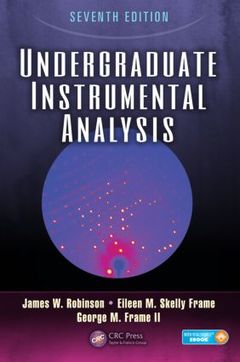Undergraduate Instrumental Analysis (7th Ed.)
Auteurs : Robinson James W., Frame Eileen Skelly, Frame II George M.

Crucial to research in molecular biology, medicine, geology, food science, materials science, and many other fields, analytical instrumentation is used by many scientists and engineers who are not chemists. Undergraduate Instrumental Analysis, Seventh Edition provides users of analytical instrumentation with an understanding of these instruments, covering all major fields of modern instrumentation. Following the tradition of earlier editions, this text is designed for teaching undergraduates and those with no analytical chemistry background how contemporary analytical instrumentation works, as well as its uses and limitations.
Each chapter provides a discussion of the fundamental principles underlying the techniques, descriptions of the instrumentation, and numerous applications. The chapters also contain updated bibliographies and problems, and most have suggested experiments appropriate to the techniques. This completely revised and updated edition covers subjects in more detail, such as a completely revised x-ray chapter, expanded coverage of electroanalytical techniques, and expansion of chromatography and mass spectrometry topics to reflect the predominance of these instruments in laboratories. This includes state-of-the-art sample introduction and mass analyzers, and the latest developments in UPLC and hyphenated techniques. The book also contains new graphics and addresses several new topics:
- Ion mobility spectrometry
- Time domain NMR (relaxometry)
- Electron spin resonance spectroscopy (ESR, EPR)
- Forensic science and bioanalytical applications
- Microcalorimetry and optical thermal instruments
- Laser-induced breakdown spectroscopy (LIBS)
This text uniquely combines instrumental analysis with organic spectral interpretation (IR, NMR, and MS). It provides detailed coverage of sampling, sample handling, sample storage, and sample preparation. In addition, the authors have included many instrument manufacturers? websites, which contain extensive resources.
Concepts of Instrumental Analytical Chemistry. Introduction to Spectroscopy. Magnetic Resonance Spectroscopy. Infrared, Near-Infrared, and Raman Spectroscopy. Visible and Ultraviolet Molecular Spectroscopy. Atomic Absorption Spectrometry. Atomic Emission Spectroscopy. X-Ray Spectroscopy. Mass Spectrometry I: Principles and Instrumentation. Mass Spectrometry II: Spectral Interpretation and Applications. Principles of Chromatography. Gas Chromatography. Chromatography with Liquid Mobile Phases. Surface Analysis. Electroanalytical Chemistry. Thermal Analysis. Acronyms Index. Index.
James W. Robinson earned his BS (Hons), PhD, and DSc from the University of Birmingham, England. Robinson began his career with the British Civil Service as a senior scientific officer before immigrating to the United States in 1955, completing a one-year term as a research associate at LSU. From 1956 to 1964, he worked in research labs at both Esso Corp. and Ethyl Corp., and in 1964 joined the LSU Department of Chemistry as an associate professor. He became professor in 1966 and retired as professor emeritus in 1993. Robinson’s pioneering research in analytical chemistry and atomic spectroscopy led to the first comprehensive book, Atomic Absorption Spectroscopy, the text Undergraduate Instrumental Analysis (now in its 7th edition). He published more than 200 peer-reviewed manuscripts and mentored 45 graduate students, many of whom have enjoyed notable careers. He was executive editor of Spectroscopy Letters, the Journal of Environmental Science and Health, the Handbook of Spectroscopy and the Practical Handbook of Spectroscopy. He was recognized as a Fellow of the Royal Chemical Society, selected for the American Institute of Chemistry’s Honor Scroll, a Guggenheim Fellowship, and received the Gold Medal Award of the New York Section of the Society of Applied Spectroscopy. He was a visiting distinguished professor at University of Colorado in 1972 and University of Sydney, Australia in 1975. He served as the Gordon Conference Chairman in Analytical Chemistry in 1974. Professor Emeritus James W. Robinson passed away in November, 2018, at 95 years of age.
Eileen M. Skelly Frame was adjunct professor, Department of Chemistry and Chemical Biology, Rensselaer Polytechnic Institute (RPI), Troy, NY, and head of Full Spectrum Analytical Consultants. Dr. Skelly Frame was the first woman commissioned from the Drexel University Army ROTC program. She graduated from Drexel summa cum laude in chemistry. She served as Medical Service Co
Date de parution : 07-2014
Ouvrage de 1200 p.
17.8x25.4 cm
Disponible chez l'éditeur (délai d'approvisionnement : 13 jours).
Prix indicatif 105,47 €
Ajouter au panierThèmes d’Undergraduate Instrumental Analysis :
Mots-clés :
Analytical Instrumentation; Spectroscopy; Spectrometry; Atomic Spectroscopy; Mass Spectrometry; instrumental method; Surface Analysis; Magnetic Resonance Spectrometry; Liquid Chromatography; Gas Chromatography; Quantitative Chemical Analysis; Principles of Chemical Analysis; Bioanalytical chemistry; Laboratory Safety; Thermal Analysis



